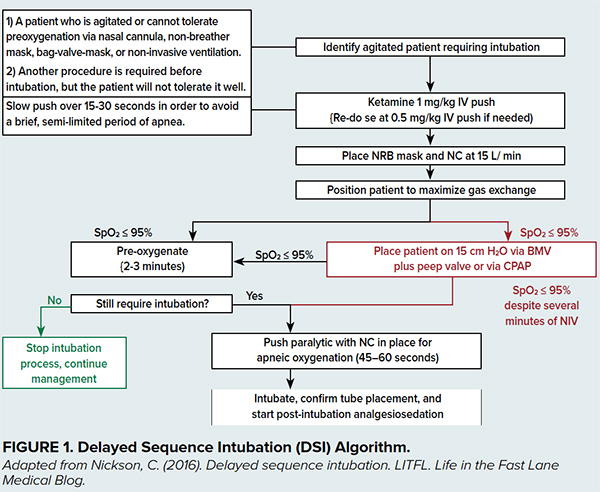We all learn our ABCs as kids, but after a couple years of medical school and residency they take on a much different meaning — airway, breathing, and circulation. In emergency medicine, there are many different methods of managing a patient’s airway, including one of the newest modalities: delayed sequence intubation (DSI).1,2
Defining DSI
The easiest way to think of DSI is as procedural sedation, with the procedure being preoxygenation, after which the patient can be paralyzed and intubated. As with any procedural sedation, we want our patients to be calm, spontaneously breathing, and protecting their airway, making ketamine the ideal induction agent, as it preserves respiratory drive and airway reflexes.
DSI may be useful in patients for whom rapid sequence intubation would inevitably result in significant hypoxemia because they cannot tolerate preoxygenation by any other means, such as patients with agitated delirium from hypoxia, hypercapnia, or an underlying medical condition.
Doing a DSI
Following the DSI algorithm (Fig. 1), the first and arguably most critical step is identifying the patient who meets the indications for DSI:
- The patient is agitated or cannot tolerate preoxygenation via nasal cannula, nonrebreather mask, bag.valve-mask, or non-invasive ventilation such as continuous positive airway pressure.
- Another procedure is required before intubation, but the patient will not tolerate it well (eg, nasogastric tube placement before intubation in the setting of a GI bleed).3

If possible, position the patient head-up at roughly 30 degrees with the auditory meatus above the sternal notch. Use the induction agent to help facilitate positioning if necessary. The ideal agent is ketamine, administered as a 1 mg/ kg slow IV push over 15–30 seconds to prevent apnea. Because the effects of ketamine are almost instantaneous, and many side effects are dose-dependent (including hypersalivation), administer 1 mg/kg first, then give further doses of 0.5 mg/kg IV as needed to achieve complete dissociation.1,2 Other induction agents have been suggested for use in patients with hypertension or tachycardia, in which the sympathomimetic effects of ketamine may be undesirable. Dexmedetomidine, remifentanil, and droperidol are all promising agents, but these lack ketamine’s reassuring safety profile, rapidity of onset, and preservation of both airway reflexes and respiratory drive.4-6
For preoxygenation, use Anton Helman’s “triple 15” rule.7 It consists of 15L O2 by NC, plus 15 L O2 by NRB, and if oxygen saturation ≤ 95%, adding 15 cm H2O of positive end-expiratory pressure by CPAP or BVM with a PEEP valve while maintaining NC.8,9 Preoxygenate for 2-3 min, then reassess for oxygenation, ventilation, and need for intubation. Rarely, DSI will avert the need for intubation by alleviating agitation and improving oxygenation to an acceptable level. In these select cases, it is reasonable to stop the DSI process and allow the induction agent to wear off, or continue managing the patient with boluses to maintain oxygenation. However, it is imperative to realize that DSI should only be initiated with the end-goal being intubation and securing the airway.
If intubation is required, administer the neuromuscular blockade, leaving the preoxygenation devices in place for 45-60 seconds while the paralytic takes effect. When ready to intubate, leave the NC in place for apneic oxygenation, intubate, confirm endotracheal tube placement, and begin post-intubation analgesia sedation.
Take-Home Point
DSI may be a useful technique to preoxygenate your patients who cannot tolerate other means of preoxygenation, and when rapid sequence intubation would be otherwise unsafe because of the risk of hypoxemia.
References
- Weingart SD, Trueger NS, Wong N, Scofi J, Singh N, Rudolph SS. Delayed sequence intubation: a prospective observational study. Ann Emerg Med. 2015;65(4):349-55.
- Gill S, Edmondson C. Re: preoxygenation, reoxygenation, and delayed sequence intubation in the Emergency Department. J Emerg Med. 2013;44(5):992-3.
- Nickson C. Delayed sequence intubation. LITFL. Accessed 2 March 2018.
- Aroni F, Iacovidou N, Dontas I, Pourzitaki C, Xanthos T. Pharmacological aspects and potential new clinical applications of ketamine: reevaluation of an old drug. J Clin Pharmacol. 2009;49:957–64.
- Carollo DS, Nossaman BD, Ramadhyani U. Dexmedetomidine: a review of clinical applications. Curr Opin Anaesthesiol. 2008;21:457–61.
- Abdelmalak B, Makary L, Hoban J, Doyle DJ. Dexmedetomidine as sole sedative for awake intubation in management of the critical airway. J Clin Anesth. 2007;19:370–3.
- Helman A. Episode 54: Preoxygenation and Delayed Sequence Intubation. Emergency Medicine Cases, 25 Nov. 2014.
- Weingart SD, Levitan RM. Preoxygenation and prevention of desaturation during emergency airway management. Ann Emerg Med. 2012;59(3):165-75.



